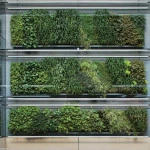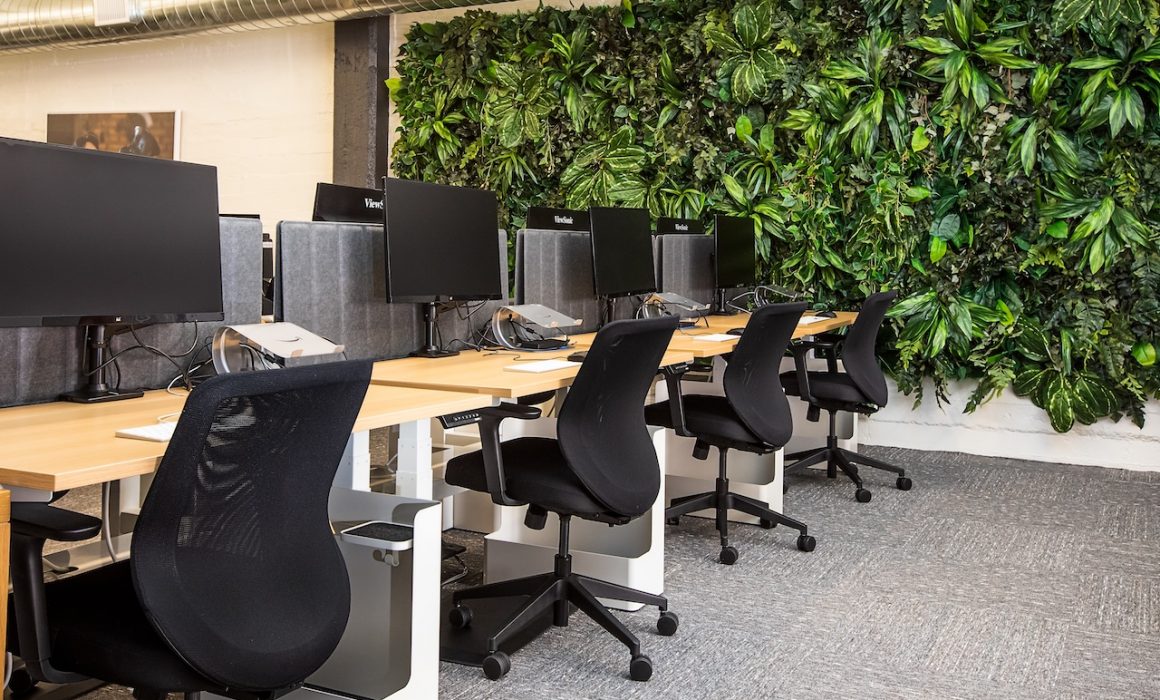Plants in the Workplace: The Surprising Benefits of a Green Office
Imagine your workspace filled with green plants, where fresh air and the beauty of nature accompany your daily tasks. That’s what you could have with a green office. Plants aren’t just aesthetically pleasing, they can improve the atmosphere of a space along with everyone’s mood. Simple changes can make your office more environmentally-friendly and an enjoyable place for people to spend time in, so why not bring the outside in and see the difference it can make?
What is a Green Office?
A green office goes beyond the occasional potted plant. It’s an intentional blending of design and nature, creating an environmentally-friendly office that benefits both employees and the planet. Whether it’s through indoor vertical gardens or recycling initiatives, it’s all about making eco-conscious choices.
The Benefits of Plants in the Workplace
Creating a green office environment involves integrating plants and sustainable practices into the workplace. This concept is gaining traction for its multifaceted benefits, which extend far beyond mere aesthetics. Here’s a detailed look into the advantages of embracing greenery and eco-friendly measures in office settings:
- Physical health improvements
Plants act as natural air filters, absorbing carbon dioxide and emitting oxygen, which can lead to improved health outcomes for employees. Greenery can also help maintain optimal indoor humidity levels, which is beneficial for respiratory health and comfort.
It’s not just the air we breathe that improves thanks to indoor plants. Your ears can benefit too: the same plants can absorb, diffract and reflect sound waves, making the office a quieter place to work.
- Psychological and emotional benefits
The presence of plants has been linked to lower stress and anxiety levels in employees. Interaction with nature can improve concentration, memory, and cognitive function, leading to increased productivity.
By bringing some of the outdoors inside, you can uplift spirits and avoid the feeling of being ‘boxed in’ that can come with working in an office building.
- Economic advantages
Improved air quality and well-being contribute to better overall health, leading to a more productive and healthy workforce. Not to mention, strategic placement of plants can assist in regulating office temperature and reducing the reliance on heating and cooling systems.
- Aesthetic appeal
Plants add colour, life and texture, improving the overall look of the office and making it a more inviting space. With a variety of plants available, it’s possible to enhance any office design, regardless of style or space constraints.
- Environmental impact
Plants absorb carbon dioxide and emit oxygen, contributing to a reduction in the overall carbon footprint of the office. Even a small change to a more eco-friendly workplace can make a difference to global environmental impact.
- Social and cultural benefits
Natural environments are known to foster creative performance, offering new perspectives and inspiration. Tending to office plants can create a sense of community among employees, encouraging teamwork and collaboration.
- Long-term sustainability
A green office can serve as an ongoing educational tool for staff, promoting sustainability practices that can extend into their personal lives. An environmentally conscious image can enhance brand reputation, attracting clients and talent who value sustainability.
Managing Risks of Plants in the Workplace
Introducing plants into the workplace isn’t without its challenges. It requires knowledge of the right types of plants to use, their maintenance needs, and considering those with allergies. How do you reap the benefits while managing the risks? By choosing hypoallergenic plants, ensuring proper care and creating plant-free zones, you can mitigate potential issues.
Green Walls and Green Roofs at the Office
The “eco way to green space” in urban environments, particularly office settings, is constantly innovating with solutions like greenwalls and green roofs.
- Green walls
Indoor vertical gardens or green walls are a show-stopping way to introduce greenery into an office without taking up valuable floor space. These living walls are not just beautiful — they’re a statement of commitment to an eco-friendly workspace.
They are a creative and space-saving way to incorporate greenery into an office environment. They involve growing plants on vertically suspended panels, using hydroponics or soil. Not only do they create an aesthetically pleasing spot in the workplace, but they also improve air quality and can create a calming, natural atmosphere that may boost employee well-being and productivity.
In choosing plants for a vertical garden in the office, it is best to look to places in nature where plants thrive in low light conditions. There is no such thing as an indoor plant but there are plants that can tolerate very light conditions, emulating the conditions of the rainforest floor, under the cover of a canopy. Many varieties of Ferns (Polypodiopsida family) and Ariods (Araceae family) are great at adapting to our human made indoor environments. We also look to epiphytic and lithophilic plants as being perfectly adaptable to the vertical landscape.These indoor vertical gardens can act as natural art, inspire creativity and even serve as conversation starters.
- Green roofs
Green roofs, on the other hand, are rooftops that are covered with vegetation. Like green walls, they can help with insulation, reducing energy costs. They also have the added benefit of managing stormwater, as they absorb rainwater and reduce runoff, which can be a significant issue in urban areas with impervious surfaces. Green roofs provide habitats for wildlife, help lower urban air temperatures (mitigating the urban heat island effect), and can even extend the life of roofing materials by protecting them from the elements.
How to Implement a Green Office Strategy
Here’s a step-by-step guide to making your office greener.
1. Conduct an environmental audit
Begin by assessing your current office environment and practices. Look at energy consumption, waste production and your current carbon footprint. This audit will highlight areas for improvement and help set measurable goals.
2. Introduce plants and green spaces
Incorporate plants into the office layout. Consider installing indoor vertical gardens or living walls to maximise greenery without sacrificing floor space. Choose plants that have air-purifying qualities and are low-maintenance.
3. Optimise energy efficiency
Switch to LED lighting, which consumes less energy and has a longer lifespan than traditional bulbs. Install smart thermostats and encourage the use of natural light wherever possible. Ensure that all appliances and electronics are energy-efficient models.
4. Reduce, reuse, recycle
Set up a recycling program within the office. Provide clearly labelled bins for paper, plastics, and metals. Encourage employees to reduce paper use and reuse materials whenever possible. We also recycle and reuse cuttings from our plants, to ensure nothing goes to waste.
5. Go digital
Minimise paper waste by adopting digital alternatives. Encourage digital filing systems, online collaboration tools, and electronic communication to reduce the need for printing.
6. Encourage sustainable commuting
Promote a green commute by providing facilities for cyclists, setting up a carpool system, or offering incentives for employees who use public transport.
7. Use eco-friendly products
Choose office supplies made from recycled materials and eco-friendly cleaning products. This supports the green market, reduces the office’s chemical footprint and is also beneficial to the health of all those in the workplace.
8. Engage and educate employees
A green office strategy works best when everyone is on board. Provide training and information on sustainability practices. Encourage employee suggestions and participation in green initiatives.
9. Monitor and adapt
Regularly review your green office strategy to assess its effectiveness. Seek feedback from staff and be prepared to adapt your approach to achieve your environmental goals.
Implementing these steps can transform any traditional office into a green office.
Key Takeaways
- A green office is more than just plants, it’s a comprehensive approach to creating an environmentally-friendly office.
- The benefits of plants in the workplace are manifold, from improving air quality to boosting creativity.
- To ensure green benefits are enjoyed by all, go into the project informed about the risks of managing plants in the workplace.
- Eco-friendly green spaces can be achieved through innovative solutions like indoor vertical gardens.
- Making your office greener can actually lead to a healthier, more productive work environment. With careful planning and a touch of nature, the transformation can be as refreshing for your staff as it is for the planet.
The green office movement is about future-proofing the workplace. It represents a shift towards a more sustainable, health-conscious and aesthetically pleasing environment that benefits everyone from the individual employee to the planet.





